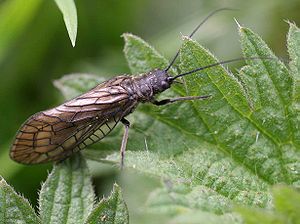Sialis
| Sialis | ||||||||||||
|---|---|---|---|---|---|---|---|---|---|---|---|---|

Common waterfly ( Sialis lutaria ) |
||||||||||||
| Systematics | ||||||||||||
|
||||||||||||
| Scientific name | ||||||||||||
| Sialis | ||||||||||||
| Latreille , 1803 |
Sialis is a genus of the mud flies or water flora flies (Sialidae) within the large winged (Megaloptera). They are distributed holarctic with around 40 species and thus represent the largest genus of mud flies.
features
As is typical for mudflies, the animals are relatively small and have a plump build with fore wing lengths of 10 to 20 millimeters. The females are usually larger than the males. The animals are mostly brown in color and have no point eyes ( ocelli ). The pronotum is relatively wide and also less long than it is wide. The legs are strongly built and have five tarsal links . The fourth link is lobed and widened. Like the other large- winged species , Sialis species have a strongly protruding wing veining on their large wings, which in the rest position are placed like a roof over the body.
Within the genus, the species can only be reliably distinguished from one another by genital morphology.
The larvae have seven pairs of characteristic, feathered gills and a long, pointed end of the abdomen on the abdomen. They have large mandibles .
distribution
The genus is distributed Holarctic. There are 10 species in Europe and four in Central Europe.
The most common species in Central Europe is Sialis lutaria , which can be found mainly in stagnant and slowly flowing waters. Sialis fuliginosa , on the other hand, prefers running waters with relatively good water quality. Sialis nigripes , which presumably can only live in large running water systems, is far rarer . Sialis sordida has only been found once on the lower Isar .
Way of life

The adults are diurnal and only fly sluggishly. You can find them in Central Europe from May to June on the bank vegetation, they only live briefly.
The females lay up to 2000 eggs in groups of around 200 on the bank vegetation of various types of water. The larvae that hatch from it drop into the water. They initially live in the water, later buried in the mud and occur up to a depth of 18 meters. The larvae predatory feed on insect larvae, worms and small clams. They usually need two years for their development, hibernate both times as larvae and go through 10 larval stages. Pupation takes place on the bank underground. The pupa burrows to the surface before the imago hatches.
Systematics (Europe)
With around 40 species, Sialis is the largest genus within the 60 species-counting family of mud flies (Sialidae). The species common in Europe are as follows:
- Common Wasserflorfliege ( sialis lutaria ) (Linnaeus, 1758)
- Sialis fuliginosa Pictet, 1836
- Sialis nigripes Pictet, 1865
- Sialis abchasica Vshivkova, 1985
- Sialis dorochovae Vshivkova, 1985
- Sialis gonzalezi Vshivkova, 1985
- Sialis klingstedti Vshivkova, 1985
- Sialis morio Klingstedt, 1932
- Sialis sibirica McLachlan, 1872
- Sialis sordida Klingstedt, 1932
The fossil species Sialis groehni and Sialis (Protosialis) baltica are also described from Baltic amber from the Eocene . These are the oldest fossil finds of this family to date.
credentials
literature
- Ekkehard Wachmann, Christoph Saure: Netzflügler, Mud and Camel Neck Flies , Naturbuch-Verlag, Augsburg 1997, ISBN 3-89440-222-9
- Wilfried Wichard: Mud flies made from Baltic amber (Megaloptera, Sialidae) . In Mitt. Geol.-Paläont. Inst. Univ. Hamburg. 80 : pp. 197-211, 2 figs., 9th plate, Hamburg 1997.
Web links
- Ord.Megaloptera mud flies ( Memento from May 11, 2008 in the Internet Archive )
